
Four years of data shows that disability awareness is not enough
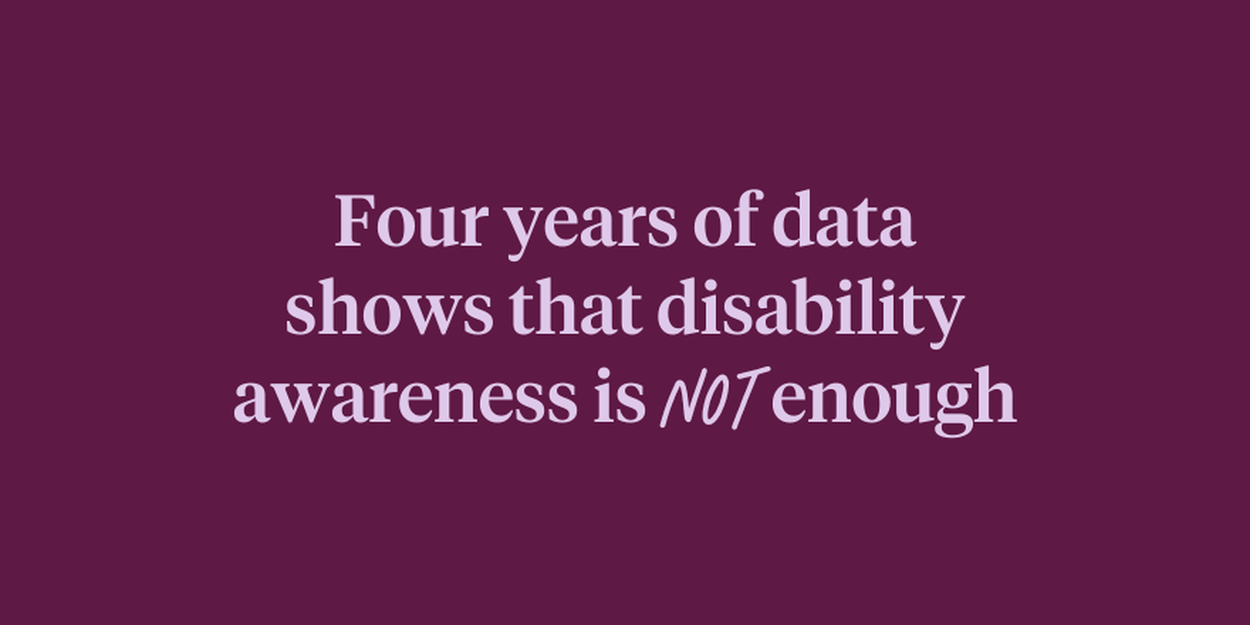
Written by

Senior Data Journalist, Culture Amp

Senior People Scientist, Culture Amp
May is Mental Health Awareness Month in the United States. In the DEI world, we love every opportunity to turn that mirror inward and self-reflect.
Awareness months are popular, but what do they accomplish?
Ironically, awareness months are not truly for those within the highlighted groups; no individual with ADHD forgets about their ADHD until someone on LinkedIn posts about Mental Health Awareness Month. Nor does someone with an amputation or diabetes become more aware of their daily realities because there is a specific time of year dedicated to the disability they have.
Instead, these observances are fundamentally for people outside the groups they center. They serve as a call to action for society at large to notice, understand, and adjust their perceptions and behaviors towards these communities. But is raising awareness enough, or does it merely scratch the surface of the profound changes needed, especially in the workplace?
According to findings from our 2024 Workplace DEI Report, it’s time to do more for disabled employees across the globe.
As part of our research for this new report, we unearthed compelling insights into the workplace experiences of historically excluded employees – including disabled people.
It’s time to face an uncomfortable truth: Within workplace DEI efforts, disability is often overlooked as a form of human diversity.
Culture Amp has previously explored the systemic barriers to employment for disabled employees, highlighting crucial areas where organizations can and must do better to foster a truly inclusive environment.
Building on these insights, we’re using Culture Amp’s ongoing research efforts to understand how living with a disability changes the workplace experience.
To unpack what is happening for disabled employees globally, let’s start with the number one reason employees join and exit an organization: career growth and opportunity.
Over four years, disabled employees have consistently rated their companies lower in career opportunities than their non-disabled peers.
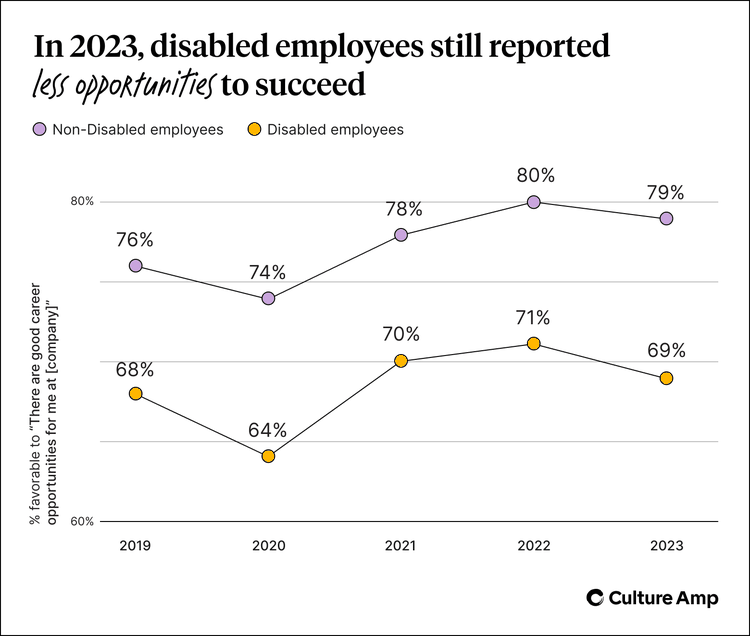
This reflects an enduring lack of career advancement opportunities for disabled employees. This persistent gap is not just a reflection of individual company policies but of broader systemic barriers that hinder true equity in career progression. So, despite ongoing awareness discussions, campaigns, and months, actual progress isn’t evident.
Meaningful differences exist across all regions between how those with and without disabilities feel about their career advancement opportunities. However, some regions have managed to reduce the gap. APAC, for example, shows non-disabled employees just 4% above disabled peers, whereas Europe shows a 13% difference.
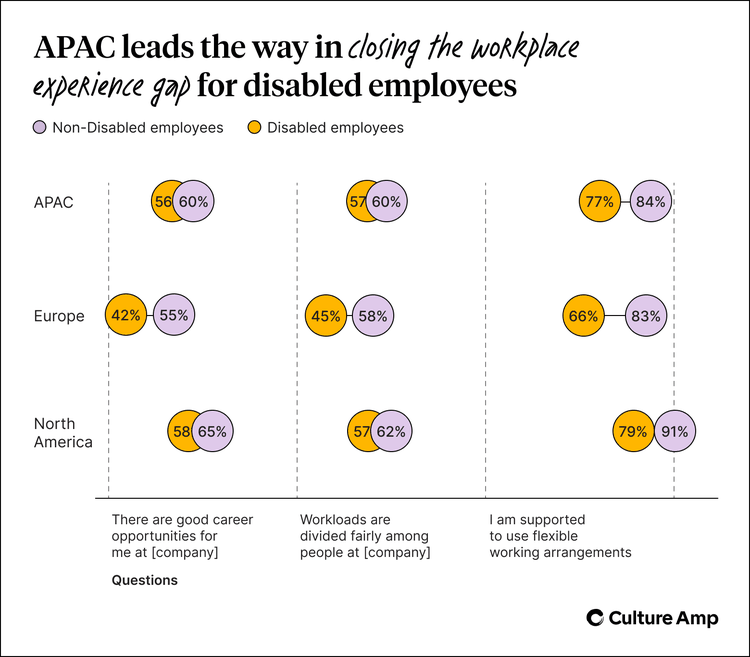
And yet, even in APAC, where the experiential gap is, in fact, more narrow, disabled employees fall meaningfully below non-disabled peers when it comes to flexible working arrangements. Could this gap be a matter of language? When a non-disabled employee requests a flexible working arrangement - like working from home for a month because their kid is out of school - that might simply be called a request. But a disabled employee? Accommodation or adjustment might be used - both legal terminology that, alone, may garner less support from management.
Such stark experiential differences by region shed light on how diverse approaches to disability inclusion can lead to different outcomes. It prompts us to ask: What policies and cultural attitudes underpin these differences, and what can global organizations learn from each region’s successes and shortcomings?
Disabled employees hold leaders accountable for inaccessible and non-inclusive work cultures
Our data reveals a growing gap in how disabled employees perceive their organization’s leadership compared to their non-disabled peers. 2023 marked a record-breaking difference in confidence in leadership between disabled and non-disabled employees.
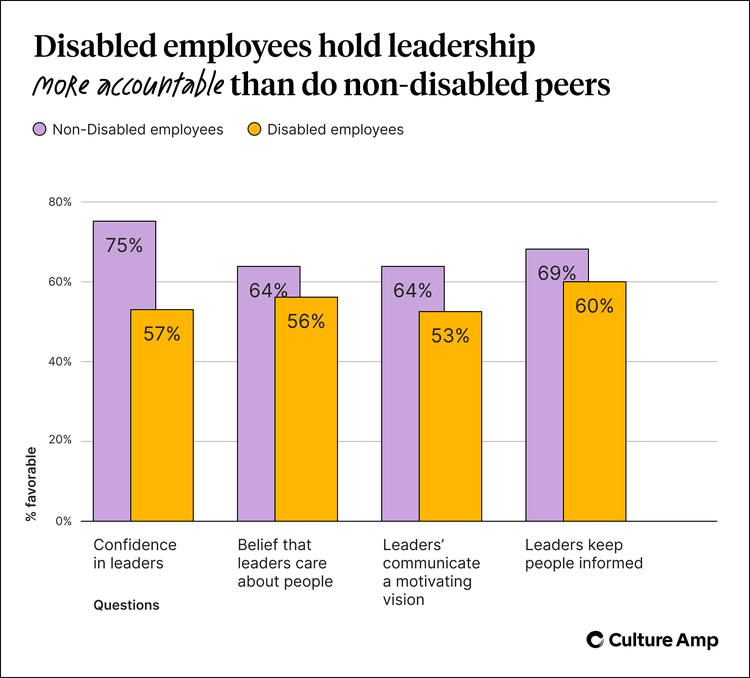
Disabled employees’ increasing skepticism is a stark reminder that leadership needs to do more than just acknowledge issues during disability-related awareness months; they must actively foster a culture of transparency and inclusivity year-round.
These findings also indicate that leaders are not sufficiently equipped to communicate with and support disabled employees. One question to consider here: How can leaders ensure they’re establishing processes and systems that meet the needs of many types of employees? Even considering adult learning principles, people process information in different ways. It’s up to the organization to communicate in a manner that will resonate with varying audiences.
Even in 2023, workplaces aren’t creating space where disabled employees feel included
At Culture Amp, we think about inclusion as a psychological state that employees can potentially experience, depending on their work environment. An employee may enter this state when they feel they belong, that they’re valued, and that they are safe to share themselves and their ideas.
In 2023, there was not a single question where disabled employees rated their experience at the same level as their non-disabled peers, let alone higher. And when it comes to that psychological state of inclusion, the difference is palpable.
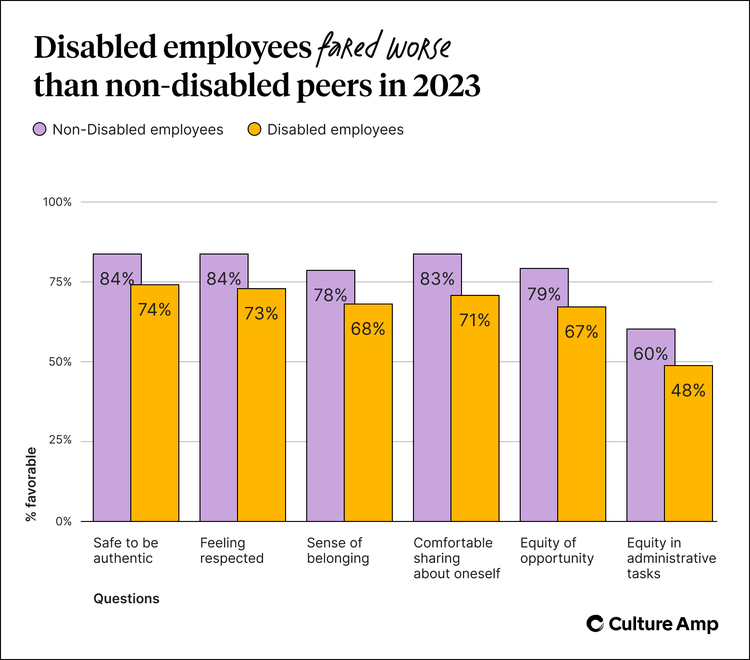
Looking at this data brings into focus how much the world of work is failing disabled employees. It also brings into sharp relief how feelings of exclusion can affect mental health and wellbeing, a particularly poignant point during Mental Health Awareness Month. When employees do not feel safe to be authentic or share information about themselves, it could also have negative impacts on the way they are perceived by their leaders, ultimately leading to fewer opportunities within the organization.
Exclusion can take an emotional and psychological toll on anyone – and it likely does take a toll on disabled employees who are already navigating bodies and minds that diverge from what is considered typical.
Companies can go beyond awareness by establishing disability-related ERGs
At Culture Amp, we have a disability-focused employee resource group (ERG), among other identity and affinity-based ERGs. In response to the challenges disabled employees face globally, our disability ERG exemplifies how organizations can go beyond mere awareness to foster genuine inclusion and equity.
Culture Amp’s Disability ERG is guided by an inclusion statement:
At Camp ID, we adopt a fluid understanding of disability, recognizing it as a natural and integral aspect of the human experience. We see disability not as a fixed identity but as an array of experiences that change over time and context. Whether temporary or permanent, apparent or non-apparent, medically diagnosed or self-identified, every person's experience with disability is unique and valid. Our community is dedicated to embracing this diversity, fostering an environment where all Campers feel valued and heard.
In his works, Brazilian philosopher and educator Paulo Freire argues that social transformation is reliant on reflection—self-reflection, group reflection, and systemic reflection—looking inward to change our actions. He calls the process of transformation “praxis” and describes it as a cycle of reflection, action, and theory.
Data can open up the first stage of praxis for HR teams, but that’s just the beginning.
We all need a little more praxis
As we reflect on the purpose and effectiveness of awareness months, we must remember that awareness alone is not enough. We must focus on sparking real change in how we think about, talk about, and address disability every day, especially in high-stakes environments like the workplace.
We urge you to reflect on the following thought-provoking questions and let them inspire you to action:
- How does our organization support the psychological inclusion of disabled employees?
- How could we do more to ensure that leaders model accessible, transparent, and trustworthy behavior with all employees, regardless of background?
- What can we learn from regions with smaller experience gaps?
- As an organization, where do we currently sit along the DEI Maturity Model? How can we leverage our current maturity level as we assess where to go next?
This dialogue is essential for understanding and dismantling the systemic barriers that perpetuate disparities in the workplace. It's not just about making adjustments; it's about transforming corporate cultures to be genuinely inclusive and equitable.

What’s happening across the DEI landscape?
Download our 2024 Workplace Diversity, Equity, and Inclusion Report to learn about the most pressing DEI trends.



